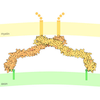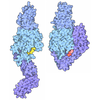+ データを開く
データを開く
- 基本情報
基本情報
| 登録情報 | データベース: PDB / ID: 8rgg | ||||||||||||||||||||||||||||||
|---|---|---|---|---|---|---|---|---|---|---|---|---|---|---|---|---|---|---|---|---|---|---|---|---|---|---|---|---|---|---|---|
| タイトル | Structure of dynein-2 intermediate chain DYNC2I2 (WDR34) in complex with dynein-2 heavy chain DYNC2H1. | ||||||||||||||||||||||||||||||
 要素 要素 |
| ||||||||||||||||||||||||||||||
 キーワード キーワード | TRANSPORT PROTEIN / dynein / cilia / intraflagellar transport / complex | ||||||||||||||||||||||||||||||
| 機能・相同性 |  機能・相同性情報 機能・相同性情報MGMT-mediated DNA damage reversal / nitric-oxide synthase inhibitor activity / deoxyribonuclease inhibitor activity / negative regulation of DNA strand resection involved in replication fork processing / negative regulation of phosphorylation / cilium movement involved in cell motility / intraciliary retrograde transport / visual behavior / methylated-DNA-[protein]-cysteine S-methyltransferase / methylated-DNA-[protein]-cysteine S-methyltransferase activity ...MGMT-mediated DNA damage reversal / nitric-oxide synthase inhibitor activity / deoxyribonuclease inhibitor activity / negative regulation of DNA strand resection involved in replication fork processing / negative regulation of phosphorylation / cilium movement involved in cell motility / intraciliary retrograde transport / visual behavior / methylated-DNA-[protein]-cysteine S-methyltransferase / methylated-DNA-[protein]-cysteine S-methyltransferase activity / 9+2 motile cilium / intraciliary transport / dynein light chain binding / spinal cord motor neuron differentiation / dynein heavy chain binding / Activation of BIM and translocation to mitochondria / embryonic skeletal system morphogenesis / motile cilium assembly / DNA-methyltransferase activity / ciliary tip / Intraflagellar transport / negative regulation of nitric oxide biosynthetic process / protein localization to cilium / coronary vasculature development / DNA alkylation repair / ciliary plasm / non-motile cilium assembly / positive regulation of smoothened signaling pathway / dorsal/ventral pattern formation / dynein complex / COPI-independent Golgi-to-ER retrograde traffic / determination of left/right symmetry / embryonic limb morphogenesis / microtubule motor activity / minus-end-directed microtubule motor activity / cytoplasmic dynein complex / dynein light intermediate chain binding / microtubule-based movement / Macroautophagy / positive regulation of double-strand break repair / ciliary base / Golgi organization / forebrain development / pericentriolar material / dynein intermediate chain binding / cytoskeletal motor activity / tertiary granule membrane / axoneme / ficolin-1-rich granule membrane / cilium assembly / enzyme inhibitor activity / spermatid development / positive regulation of insulin secretion involved in cellular response to glucose stimulus / Hedgehog 'off' state / COPI-mediated anterograde transport / Amplification of signal from unattached kinetochores via a MAD2 inhibitory signal / Mitotic Prometaphase / axon cytoplasm / EML4 and NUDC in mitotic spindle formation / centriole / Loss of Nlp from mitotic centrosomes / Loss of proteins required for interphase microtubule organization from the centrosome / substantia nigra development / Recruitment of mitotic centrosome proteins and complexes / MHC class II antigen presentation / Recruitment of NuMA to mitotic centrosomes / Anchoring of the basal body to the plasma membrane / HSP90 chaperone cycle for steroid hormone receptors (SHR) in the presence of ligand / Resolution of Sister Chromatid Cohesion / AURKA Activation by TPX2 / methyltransferase activity / filopodium / kidney development / RHO GTPases Activate Formins / protein processing / kinetochore / HCMV Early Events / apical part of cell / Aggrephagy / mitotic spindle / Separation of Sister Chromatids / Regulation of PLK1 Activity at G2/M Transition / site of double-strand break / scaffold protein binding / nuclear membrane / methylation / microtubule / cytoskeleton / nuclear body / cilium / ciliary basal body / DNA repair / apoptotic process / DNA damage response / centrosome / Neutrophil degranulation / negative regulation of apoptotic process / protein-containing complex binding / nucleolus / enzyme binding 類似検索 - 分子機能 | ||||||||||||||||||||||||||||||
| 生物種 |  Homo sapiens (ヒト) Homo sapiens (ヒト) | ||||||||||||||||||||||||||||||
| 手法 | 電子顕微鏡法 / 単粒子再構成法 / クライオ電子顕微鏡法 / 解像度: 4 Å | ||||||||||||||||||||||||||||||
 データ登録者 データ登録者 | Mukhopadhyay, A.G. / Toropova, K. / Daly, L. / Wells, J. / Vuolo, L. / Mladenov, M. / Seda, M. / Jenkins, D. / Stephens, D.J. / Roberts, A.J. | ||||||||||||||||||||||||||||||
| 資金援助 |  英国, 9件 英国, 9件
| ||||||||||||||||||||||||||||||
 引用 引用 |  ジャーナル: EMBO J / 年: 2024 ジャーナル: EMBO J / 年: 2024タイトル: Structure and tethering mechanism of dynein-2 intermediate chains in intraflagellar transport. 著者: Aakash G Mukhopadhyay / Katerina Toropova / Lydia Daly / Jennifer N Wells / Laura Vuolo / Miroslav Mladenov / Marian Seda / Dagan Jenkins / David J Stephens / Anthony J Roberts /  要旨: Dynein-2 is a large multiprotein complex that powers retrograde intraflagellar transport (IFT) of cargoes within cilia/flagella, but the molecular mechanism underlying this function is still emerging. ...Dynein-2 is a large multiprotein complex that powers retrograde intraflagellar transport (IFT) of cargoes within cilia/flagella, but the molecular mechanism underlying this function is still emerging. Distinctively, dynein-2 contains two identical force-generating heavy chains that interact with two different intermediate chains (WDR34 and WDR60). Here, we dissect regulation of dynein-2 function by WDR34 and WDR60 using an integrative approach including cryo-electron microscopy and CRISPR/Cas9-enabled cell biology. A 3.9 Å resolution structure shows how WDR34 and WDR60 use surprisingly different interactions to engage equivalent sites of the two heavy chains. We show that cilia can assemble in the absence of either WDR34 or WDR60 individually, but not both subunits. Dynein-2-dependent distribution of cargoes depends more strongly on WDR60, because the unique N-terminal extension of WDR60 facilitates dynein-2 targeting to cilia. Strikingly, this N-terminal extension can be transplanted onto WDR34 and retain function, suggesting it acts as a flexible tether to the IFT "trains" that assemble at the ciliary base. We discuss how use of unstructured tethers represents an emerging theme in IFT train interactions. | ||||||||||||||||||||||||||||||
| 履歴 |
|
- 構造の表示
構造の表示
| 構造ビューア | 分子:  Molmil Molmil Jmol/JSmol Jmol/JSmol |
|---|
- ダウンロードとリンク
ダウンロードとリンク
- ダウンロード
ダウンロード
| PDBx/mmCIF形式 |  8rgg.cif.gz 8rgg.cif.gz | 307.6 KB | 表示 |  PDBx/mmCIF形式 PDBx/mmCIF形式 |
|---|---|---|---|---|
| PDB形式 |  pdb8rgg.ent.gz pdb8rgg.ent.gz | 表示 |  PDB形式 PDB形式 | |
| PDBx/mmJSON形式 |  8rgg.json.gz 8rgg.json.gz | ツリー表示 |  PDBx/mmJSON形式 PDBx/mmJSON形式 | |
| その他 |  その他のダウンロード その他のダウンロード |
-検証レポート
| 文書・要旨 |  8rgg_validation.pdf.gz 8rgg_validation.pdf.gz | 1.5 MB | 表示 |  wwPDB検証レポート wwPDB検証レポート |
|---|---|---|---|---|
| 文書・詳細版 |  8rgg_full_validation.pdf.gz 8rgg_full_validation.pdf.gz | 1.5 MB | 表示 | |
| XML形式データ |  8rgg_validation.xml.gz 8rgg_validation.xml.gz | 47.6 KB | 表示 | |
| CIF形式データ |  8rgg_validation.cif.gz 8rgg_validation.cif.gz | 73.2 KB | 表示 | |
| アーカイブディレクトリ |  https://data.pdbj.org/pub/pdb/validation_reports/rg/8rgg https://data.pdbj.org/pub/pdb/validation_reports/rg/8rgg ftp://data.pdbj.org/pub/pdb/validation_reports/rg/8rgg ftp://data.pdbj.org/pub/pdb/validation_reports/rg/8rgg | HTTPS FTP |
-関連構造データ
- リンク
リンク
- 集合体
集合体
| 登録構造単位 | 
|
|---|---|
| 1 |
|
- 要素
要素
| #1: タンパク質 | 分子量: 515223.031 Da / 分子数: 1 / 由来タイプ: 組換発現 / 詳細: DYNC2H1 with N-terminal SNAPf tag / 由来: (組換発現)  Homo sapiens (ヒト) Homo sapiens (ヒト)遺伝子: MGMT, DYNC2H1, DHC1B, DHC2, DNCH2, DYH1B, KIAA1997 発現宿主:  参照: UniProt: P16455, UniProt: Q8NCM8, methylated-DNA-[protein]-cysteine S-methyltransferase | ||
|---|---|---|---|
| #2: タンパク質 | 分子量: 122865.156 Da / 分子数: 1 / 由来タイプ: 組換発現 / 由来: (組換発現)  Homo sapiens (ヒト) / 遺伝子: DYNC2I1, WDR60 Homo sapiens (ヒト) / 遺伝子: DYNC2I1, WDR60発現宿主:  参照: UniProt: Q8WVS4 | ||
| #3: タンパク質 | 分子量: 60639.129 Da / 分子数: 1 / 由来タイプ: 組換発現 詳細: DYNC2I2 (also known as WDR34) with C-terminal Strep tag 由来: (組換発現)  Homo sapiens (ヒト) / 遺伝子: DYNC2I2, WDR34 Homo sapiens (ヒト) / 遺伝子: DYNC2I2, WDR34発現宿主:  参照: UniProt: Q96EX3 | ||
| #4: タンパク質 | 分子量: 10934.576 Da / 分子数: 2 / 由来タイプ: 組換発現 / 由来: (組換発現)  Homo sapiens (ヒト) / 遺伝子: DYNLRB1, BITH, DNCL2A, DNLC2A, ROBLD1, HSPC162 Homo sapiens (ヒト) / 遺伝子: DYNLRB1, BITH, DNCL2A, DNLC2A, ROBLD1, HSPC162発現宿主:  参照: UniProt: Q9NP97 #5: タンパク質 | 分子量: 10381.899 Da / 分子数: 2 / 由来タイプ: 組換発現 / 由来: (組換発現)  Homo sapiens (ヒト) / 遺伝子: DYNLL1, DLC1, DNCL1, DNCLC1, HDLC1 Homo sapiens (ヒト) / 遺伝子: DYNLL1, DLC1, DNCL1, DNCLC1, HDLC1発現宿主:  参照: UniProt: P63167 |
-実験情報
-実験
| 実験 | 手法: 電子顕微鏡法 |
|---|---|
| EM実験 | 試料の集合状態: PARTICLE / 3次元再構成法: 単粒子再構成法 |
- 試料調製
試料調製
| 構成要素 | 名称: Dynein-2 complex / タイプ: COMPLEX / Entity ID: all / 由来: RECOMBINANT |
|---|---|
| 分子量 | 実験値: NO |
| 由来(天然) | 生物種:  Homo sapiens (ヒト) Homo sapiens (ヒト) |
| 由来(組換発現) | 生物種:  |
| 緩衝液 | pH: 7.5 |
| 試料 | 包埋: NO / シャドウイング: NO / 染色: NO / 凍結: YES |
| 急速凍結 | 凍結剤: ETHANE |
- 電子顕微鏡撮影
電子顕微鏡撮影
| 実験機器 |  モデル: Titan Krios / 画像提供: FEI Company |
|---|---|
| 顕微鏡 | モデル: FEI TITAN KRIOS |
| 電子銃 | 電子線源:  FIELD EMISSION GUN / 加速電圧: 300 kV / 照射モード: FLOOD BEAM FIELD EMISSION GUN / 加速電圧: 300 kV / 照射モード: FLOOD BEAM |
| 電子レンズ | モード: BRIGHT FIELD / 最大 デフォーカス(公称値): 3500 nm / 最小 デフォーカス(公称値): 1500 nm |
| 撮影 | 電子線照射量: 50.6 e/Å2 フィルム・検出器のモデル: GATAN K3 BIOQUANTUM (6k x 4k) |
- 解析
解析
| CTF補正 | タイプ: PHASE FLIPPING AND AMPLITUDE CORRECTION |
|---|---|
| 3次元再構成 | 解像度: 4 Å / 解像度の算出法: FSC 0.143 CUT-OFF / 粒子像の数: 113479 / 詳細: Global resolution 4.0A / 対称性のタイプ: POINT |
 ムービー
ムービー コントローラー
コントローラー







 PDBj
PDBj




















